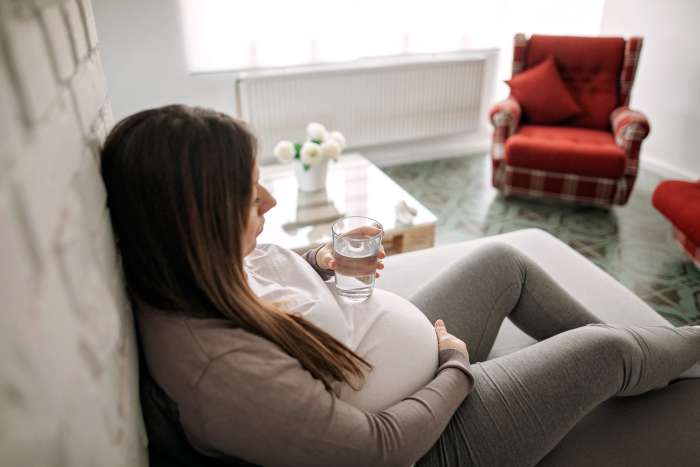One of the many health issues a woman may face during her pregnancy is symphysis pubis dysfunction (SPD). SPD is pelvic pain that occurs when the ligaments surrounding your pelvic joints become more flexible as they prepare for labor and delivery.
We’re going to look at what causes this pelvic pain during pregnancy, as well as the symptoms, and what you can do to seek relief if you experience pregnancy-related SPD.
What causes symphysis pubis dysfunction?
Symphysis pubis dysfunction involves the pubic symphysis joint that sits between your public bones, above your vulva. SPD occurs when this joint creates more movement than usual. This happens due to the ligaments involved.
Some ligaments hold the joint in place so that your pelvic bones don’t move or shift more than is comfortable. When you’re pregnant, there are hormonal changes that cause these ligaments to get loose.
This allows the joint to become flexible enough for your pelvic bones to widen so that you can deliver your baby. While this is important for labor and delivery, when the ligaments get too relaxed, it can be extremely painful.
How common is SPD in pregnancy?
About 30% of pregnant women report symptoms linked to symphysis pubis dysfunction. While it’s not extremely rare, it is also not something every pregnant woman will experience.
Hair Changes During Pregnancy
Hair Changes During Pregnancy Daddy Alert! This is not a good time to test your partner's sense of humor. A woman who has always been quick to laugh at herself will surprise you with a wailing retreat from the room if you dare mention the fact that she seems to be growing a mustache. Read More
Can SPD lead to pregnancy complications?
While it can be very painful for a pregnant woman, SPD is not harmful to an unborn baby. Many women who experience this problem are still able to deliver vaginally.
It may be a good idea to talk to your OB-GYN because the pain and discomfort SPD causes can lead to mental health issues such as postpartum depression once your baby is born. Speaking to your healthcare provider can help if you’re dealing with these issues.
What are the signs and symptoms of SPD?
The signs and symptoms of SPD are going to differ from woman to woman, depending on how weight and pressure are distributed throughout the body.
The way you move can make the pain more severe and put more pressure on your joints. As you get closer to delivery, the pain usually gets worse.
Here are some common symptoms of SPD to look for:
- Shooting pain from the front or back of your pelvis
- Steady pain that radiates throughout your lower abdomen, back, groin, perineum, thigh and leg
- Pain that travels to your thighs
- Grinding or clicking sound in the pelvis
- Feeling fatigued
Many women experience greater pain in the pelvic region when they are walking, going up and down stairs, bending forward, or getting up from a chair.
What does SPD feel like?

SPD pain can feel tender in the front of the pubic bone which can also radiate to the hips. It can get worse with certain movements. The pain can come and go suddenly and can be extremely painful when you first wake up in the morning and get out of bed.
How is SPD diagnosed?
If you suspect you have SPD, your doctor will do an exam to check for any pain or swelling in the pelvic area. Your doctor may also see how some specific movements impact your pain. You may also have an ultrasound or other safe test to take a closer look at your joints.
What risk factors are involved with SPD?
Several factors can put you at a higher risk of developing SPD.
These include:
- Having SPD with a previous pregnancy
- Multiple pregnancies
- Pelvic trauma
- Being overweight
- Having a very large baby
- Rapid descent of the baby’s head during the pushing stage of labor
How to treat symphysis pubis pain
If you are experiencing symphysis pubis pain, always talk to your doctor before starting any treatments. Some common treatments for pain relief can include:
To Do
- Exercises to strengthen the pelvic floor muscles as well as Kegels and modified squats (these can also help with low back pain)
- Applying an ice pack or heating pad to the public bone, not the abdomen, for no more than 15 minutes at a time
- Pelvic support belt to reduce pain while moving
- Doctor-approved pain relievers (Acetaminophen is very common.)
- Physical therapy if doctor recommended
- Physiotherapist if approved by your health professionals
- Acupuncture if doctor approved
To Avoid
- Avoid putting weight on one leg
- Avoid twisting movements, turn your entire body instead
- Don’t lift or push heavy items or carry another child near your hip area
- Try not to sit or stand for long periods
When it comes to pregnancy-related symphysis pubis dysfunction management, physiotherapy can help if your doctor approves it. This can improve muscle function as well as pelvic joint stability.
A physical therapist or physiotherapist can provide manual therapy to ensure that all of your joints move normally. He or she can also suggest comfortable birthing positions.
Hydrotherapy can be another option. Doing exercises in the water can take the stress off your joints and allow you to move more easily.
When will SPD pain go away?
As your pregnancy progresses and your body grows and weight shifts, you may experience different types of pelvic pain.
The pain associated with SPD usually goes away when your body stops producing the relaxin hormone after your baby is born. This is when your ligaments will return to their pre-pregnant state.
If the pain doesn’t go away after you give birth, talk to your OB-GYN to see if there may be another issue going on.
FAQs About SPD
Is there anything I can do to prevent developing SPD?
Unfortunately, there isn’t much you can do to prevent yourself from developing SPD during pregnancy. If you’ve had a pelvic injury, you may be more prone to developing SPD when you’re pregnant.
What is the difference between Symphysis Pubis Dysfunction and Pubic Symphysis Diastasis?
Besides symphysis pubis dysfunction, there’s also something called pubic symphysis diastasis (DSP). Both of these involve the pubic symphysis joint. With pubic symphysis diastasis, the pubic joint is separated too far.
This occurs when the pubic joint opens more than 10 mm. This can happen before delivery, during delivery, or postpartum. This is a very rare condition. Treatment can involve wearing a stabilization brace or belt as well as doing specific exercises.
What is the difference between SPD and round ligament pain?
Round ligament pain is a sharp pain often felt in the lower belly or groin area on one or both sides. This pain is typical during the second trimester and is considered a normal part of pregnancy. SPD is more of an instability in your pelvic joint as discussed above.
Will my pain go away right after I give birth?
The pain may go away quickly, but some women report feeling worse after all of the physical pains of labor. The first few days after giving birth can be the hardest.
Wearing a support belt or pregnancy belly wrap can be helpful until the pain subsides. It can take up to 6 weeks after giving birth for the pain to completely go away.
Will the pain return if I get pregnant again?
Each pregnancy is different, but some women who have SPD during one pregnancy do see it return again the second time around.
The Bottom Line on SPD
Symphysis pubis dysfunction occurs when the joint between your left and right pelvic bones (pubic symphysis) creates more movement than usual. This is common among pregnant women and usually resolves itself once the baby is born.
Many women with SPD report more severe pain during their third trimester as they get closer to their due date.
Having SPD with a previous pregnancy or having a pelvic injury are among the factors that can put you at a higher risk of developing SPD. There is not much that can be done to prevent it.
Doing doctor-approved pelvic floor exercises and Kegels can help to alleviate some of the pain. Some women benefit from physical therapy as well as acupuncture.
Always consult with your doctor before beginning any treatment for SPD. Pain from SPD usually goes away after giving birth but can take a few weeks.
Any time you are experiencing pain during pregnancy, always consult your obstetrician so that you can be properly diagnosed and receive the right treatment for your condition.



